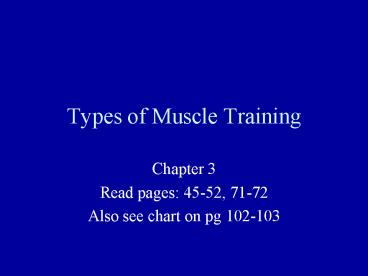Types of Muscle Training - PowerPoint PPT Presentation
1 / 16
Title:
Types of Muscle Training
Description:
TV, magazines, fitness experts, health clubs. It's a very INDIVIDUAL PROCESS ... Examples: biceps curl, leg extension mach., calf raises, triceps pushdowns, crunches ... – PowerPoint PPT presentation
Number of Views:33
Avg rating:3.0/5.0
Title: Types of Muscle Training
1
Types of Muscle Training
- Chapter 3
- Read pages 45-52, 71-72
- Also see chart on pg 102-103
2
Resistance Training Programs
- The Media
- TV, magazines, fitness experts, health clubs
- Its a very INDIVIDUAL PROCESS
- It needs analysis (NEEDS ANALYSIS)
- What is the goal?
- Other factors RT exp., time to train,
facilities, - And special needs
3
Five Principles
- 1. Specificity of Training-
- 2. GAS (general adaptation syndrome)-
- 3. SAID (specific adaptation to imposed demands)-
- 4. Variation in Training-
- 5. Prioritization Training
4
Acute Training Variables
- Exercises chosen
- Order in which exercises are performed
- Intensity (load) of exercises
- Volume (sets repetitions) of exercises
- Rest time between sets
5
Acute Training Variables
- These variables can change within a single
workout will determine the outcome of training
over the long term. - These choices affect the resistance training
adaptations - Whats the goal? Hypertrophy, Strength, Power or
Endurance?
6
Choice of Exercises
- Remember
- Specificity
- Muscle tissue not activated wont benefit
- Determine goal of RT, then select Exercises
7
Primary Exercises(Structural exercises)
- Prime movers
- Major muscle groups
- Involve multiple joints (gt 2 joints)
- Examples power clean, deadlift, squat
- Bench press, lat puldown
8
Primary Exercises(Structural Exercises)
- Require neural coordination
- Takes additional coaching time
- More sport or ADL specific (function)
- More muscle tissue activated
- Hormone response metabolic demands
9
Assistance Exercises(Isolation Exercises)
- Exercise that train 1-muscle group
- Aids in movement of prime movers
- Body part specific
- Simple movement patterns
- Examples biceps curl, leg extension mach., calf
raises, triceps pushdowns, crunches
10
Order of Exercises
- Exercising larger muscle groups 1st provides
superior training stimulus to all muscles
involved. - Exercising more larger muscle groups stimulates
greater neural, metabolic, endocrine
circulatory responses. - This benefits the training of other muscles later
in the workout
11
EX Order Recommendations
- 1. Target large before small muscle groups
- 2. Perform Primary before Assistance Exs
- 3. Alternate push/pull for total body session
- 4. Alternate upper/lower body
- 5.Emphasis on weak pts. then strong pts.
- Perf. olympic lifts before other lifts
- Perf. more intense Exs before less intense
12
Intensity (Load)
- The amount of resistance or weight used for a
specific exercise - RM (repetition maximum)-
- Estimated 1RM (pg 102)-
- RM Target Zones are effective for avg person
- Resistance used should place you w/in a targeted
group of reps to meet RT goal
13
Volume(sets repetitions)
- Volume is the amount of sets repetitions
performed in an exercise session - Low Volume training-
- High Volume training-
- Single set training vs. Mult. Set Research
- gt 1 set is needed for progressive development
improved performance
14
Rest Periods
- Between sets and exercises
- Determine energy source resynthesis(ATP)
- Concentrations of lactae in the blood
- The length of rest can alter the metabolic,
hormonal, and cardiovascular responses to a RT
set and subsequent sets
15
Rest Periods
- Structural exs require at least 3-5min rest
- Assistance exs may only need 1-min or less
- Max intensity for advanced requires near full
recovery of energy stores for the next lift.
They are near genetical potential - For novice -intermed. loads are less so rest is
less (2-3min)
16
Rest Periods
- Stressing the energy system does however enhance
muscle recovery, leading to hypertrophy - Pages 53-70 of chapter 3 to be covered later in
semester































